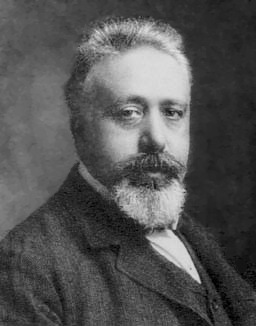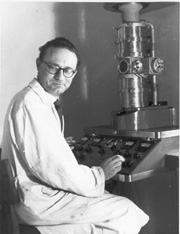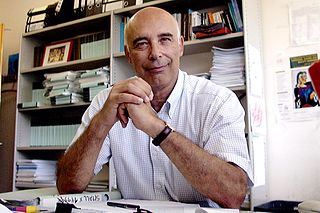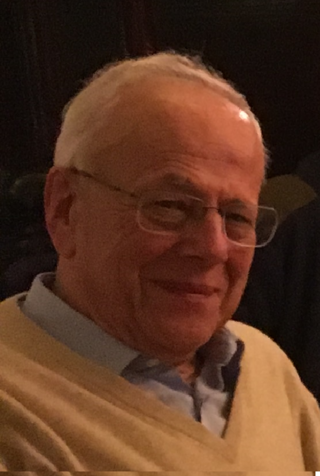
Vito Volterra was an Italian mathematician and physicist, known for his contributions to mathematical biology and integral equations, being one of the founders of functional analysis.

Tullio Levi-Civita, was an Italian mathematician, most famous for his work on absolute differential calculus and its applications to the theory of relativity, but who also made significant contributions in other areas. He was a pupil of Gregorio Ricci-Curbastro, the inventor of tensor calculus. His work included foundational papers in both pure and applied mathematics, celestial mechanics, analytic mechanics and hydrodynamics.

Francesco Calogero is an Italian physicist, active in the community of scientists concerned with nuclear disarmament.

Giovanni Jona-Lasinio, sometimes called Gianni Jona, is an Italian theoretical physicist, best known for his works on quantum field theory and statistical mechanics. He pioneered research concerning spontaneous symmetry breaking, and the Nambu–Jona-Lasinio model is named after him. When Yoichiro Nambu received the Nobel Prize, Jona-Lasinio gave the Nobel Lecture in his place, as a recognition from Nambu for their joint work. At present, he holds a faculty position in the Physics Department of Sapienza University of Rome, and is a full member of the Accademia dei Lincei.

Nicola Cabibbo was an Italian physicist best known for his work on the weak interaction, particularly his introduction of the Cabibbo angle. Interested in science from a young age, he studied physics at the Sapienza University of Rome, graduating in 1958 with a thesis completed under Bruno Touschek.

Mario Ageno is considered one of Italy's most important biophysicists.

Giorgio Parisi is an Italian theoretical physicist, whose research has focused on quantum field theory, statistical mechanics and complex systems. His best known contributions are the QCD evolution equations for parton densities, obtained with Guido Altarelli, known as the Altarelli–Parisi or DGLAP equations, the exact solution of the Sherrington–Kirkpatrick model of spin glasses, the Kardar–Parisi–Zhang equation describing dynamic scaling of growing interfaces, and the study of whirling flocks of birds. He was awarded the 2021 Nobel Prize in Physics jointly with Klaus Hasselmann and Syukuro Manabe for groundbreaking contributions to theory of complex systems, in particular "for the discovery of the interplay of disorder and fluctuations in physical systems from atomic to planetary scales".

Emilio Zavattini was an Italian particle physicist.
Sergio Ferrara is an Italian physicist working on theoretical physics of elementary particles and mathematical physics. He is renowned for the discovery of theories introducing supersymmetry as a symmetry of elementary particles and of supergravity, the first significant extension of Einstein's general relativity, based on the principle of "local supersymmetry". He is an emeritus staff member at CERN and a professor emeritus at the University of California, Los Angeles.

Gaetano Fichera was an Italian mathematician, working in mathematical analysis, linear elasticity, partial differential equations and several complex variables. He was born in Acireale, and died in Rome.

Enzo Martinelli was an Italian mathematician, working in the theory of functions of several complex variables: he is best known for his work on the theory of integral representations for holomorphic functions of several variables, notably for discovering the Bochner–Martinelli formula in 1938, and for his work in the theory of multi-dimensional residues.

Franco Pacini was an Italian astrophysicist and professor at the University of Florence. He carried out research, mostly in High Energy Astrophysics, in Italy, France, United States and at the European Southern Observatory.

Riccardo Barbieri is an Italian theoretical physicist and a professor at the Scuola Normale Superiore di Pisa. He has written more than two hundred research papers in the field of theoretical elementary particle physics, and has been particularly influential in physics beyond the Standard Model.
Maria Adelaide Sneider was an Italian mathematician working on numerical and mathematical analysis. She is known for her work on the theory of electrostatic capacities of non-smooth closed hypersurfaces: Apart from the development of precise estimates for the numerical approximation of the electrostatic capacity of the unit cube, this work also led her to give a rigorous proof of Green's identities for large classes of hypersurfaces with singularities, and later to develop an accurate mathematical analysis of the points effect. She is also known for her contributions to the Dirichlet problem for pluriharmonic functions on the unit sphere of

Guido Altarelli was an Italian theoretical physicist.

Enrico Bompiani was an Italian mathematician, specializing in differential geometry.

Ugo Amaldi; born 26 August 1934, is an Italian physicist, mainly working in the fields of particle and medical physics.
Mario Pulvirenti is an Italian mathematician, Professor emeritus of Mathematical Physics at Sapienza University of Rome.

Sergio Doplicher is an Italian mathematical physicist, who mainly dealt with the mathematical foundations of quantum field theory and quantum gravity.

Giorgio Benedek is an Italian physicist, academic and researcher. He is an Emeritus Professor of Physics of Matter at University of Milano-Bicocca and Director of the International School of Solid State Physics at Ettore Majorana Foundation and Centre for Scientific Culture.

















